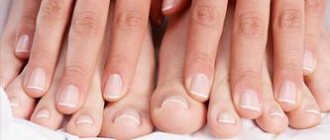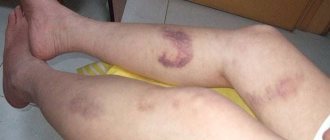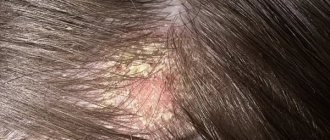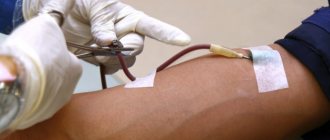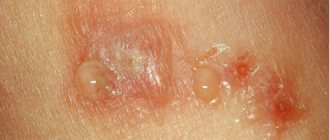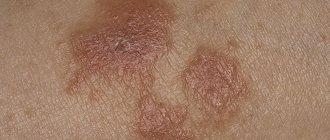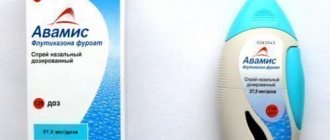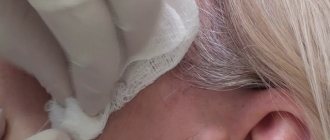Hello everybody. Our article today is about how to treat psoriasis on the elbows. This is a chronic pathology that, in most cases, affects people of middle age. It is impossible to get rid of it forever; it tends to recur in the presence of provoking factors.
Psoriasis is treated comprehensively at home using external and internal medications, folk remedies, and physiotherapy. Each medication is prescribed by a doctor after an accurate diagnosis, depending on the patient’s age, course of the disease, and the presence of contraindications.
What causes disease on elbows and knees: causes
Psoriasis on the elbows, like any other type of similar manifestation, occurs due to malfunctions of the immune system.
As a result of the disturbances, a mechanism is triggered in which skin cells begin to renew almost 5 times faster than in healthy people. As a result, the cells that do not have time to die gather into papules and become inflamed, subsequently becoming covered with flaky silver-white scales.
Despite the large scale of research conducted in this area, the causes of the disease have not been fully identified. However, experts still agree that the main cause of the development of psoriasis is heredity, the “awakening” of which requires the influence of a third-party factor.
Precipitating circumstances include:
- severe stress or prolonged depression;
- hormonal imbalances;
- disturbances in the functioning of the endocrine system;
- mechanical damage to the skin;
- frequent allergic reactions;
- excessive dry skin;
- bad habits;
- some other factors.
People with a hereditary predisposition to the development of psoriasis should try in every possible way to avoid exposure to provoking circumstances. Otherwise, the risk of exacerbation of the disease is quite high.
Symptoms
In the very early stages of this unpleasant disease, individual rashes of varying sizes appear on the patient’s elbows, prone to further growth. If treatment is not started in time, the rash will grow, forming extensive plaques. The main signs that this is psoriasis on the elbow, and not a rash of another origin:
- The surface of the rash consists of silvery scales that are easily separated from the plaque.
- If you scrape the skin, a thin film will also come off along with the scales. Beneath it is a pink surface with protruding droplets of blood.
- Sometimes psoriasis manifests itself in the form of voluminous nodules with a rim. In this case there are no scales on them.
The disease is characterized by an undulating pattern, in which exacerbations are replaced by remission. As the disease improves, the inflammation on the elbows may become significantly paler, stop bothering you, or even disappear completely.
During remission, plaques begin to dissolve from their center, gradually turning pale. Over time, areas of skin devoid of pigment remain in their place. If remission is incomplete, psoriasis may leave a small rash on the elbows.
If the disease has not been treated for a long time, large rashes may not change for a long time. In an untreated, chronic form, psoriasis is very difficult to get rid of, so it is better to consult a doctor promptly.
Most patients with this unpleasant diagnosis note that they do not begin to feel worse during the period of exacerbation of the disease. The most common cycle is 1.5-2 months, after which the rash disappears and remission occurs.
Since the disease is accompanied by itching of varying degrees of intensity, it can bring significant discomfort to the patient.
The current level of medicine does not allow treating psoriasis on the elbows until complete recovery; this is a chronic disease. The task of doctors is to put the patient into a state of stable and long-term remission.
Symptoms and signs of the initial stage of the disease
Psoriasis of this type is characterized by the appearance of small pink spots in the elbow area, which over time increase in size, become more convex and dense.
The skin in the area of the papules becomes inflamed, and after a certain number of days, silver-white scales appear on its surface, which are easily separated from the plaques by mechanical action.
After removing the keratinized components, blood droplets may appear on the surface of the inflamed area.
Often a pink “halo” appears around the spots, not covered with flaky scales. Constantly growing spots gradually increase in size and merge into one large formation.
As a rule, the appearance of spots is accompanied by itching, a feeling of tightness of the skin and other unpleasant sensations. The disease progresses in waves: stages of remission alternate with exacerbation of the disease.
The patient should contact a specialist as soon as he notices the first manifestations of the disease.
Forms
The undulating course of the disease, when a spontaneous period alternates with improvement, is not the only component of the insidiousness of psoriasis. The severity of the inflammatory process depends on the nature of the rash; another important factor is the form. When rashes are localized on the elbows, a simple (vulgar) type of illness often occurs, which is characterized by redness, peeling, and itching. The advanced form of the disease threatens complications and the appearance of pustular, erythrodermic, seborrheic type of psoriasis - with them the affected area will expand.
- How to recover Yandex mail if you forgot your login and password
- Jellied meat in a slow cooker - recipes with photos. How to cook jellied chicken, beef and pork in a slow cooker
- What is dratuti
What does elbow psoriasis look like?
Elbow psoriasis in most cases is characterized by the presence of dry pink or bright red plaques on the skin of the elbow, covered with scales and having a pale pink halo.
If the patient has a pustular form of the disease, in addition to papules in the elbow area, small blisters (pustules) filled with clear liquid or pus may also appear (in the case of a secondary infection). Only the attending physician should make a diagnosis and prescribe treatment.
Causes
Scientific research, which continues to be conducted, has not yet been able to determine with complete certainty the source of the disease, and among the medical versions of the causes of psoriasis in the elbow area there are the following:
- Genetic predisposition is an important statistical factor. If one of the parents has chronic skin inflammation, then there is a high probability that the child will also develop psoriasis.
- Ingress of specific substances penetrating through injured areas of the skin. The affected areas of the epidermis begin to thicken, the body begins to struggle with abnormal symptoms and rejects the cells, which externally manifests itself as a fungus on the elbows.
- Disruption of the work of T-lymphocytes, which are faced with the task of creating a barrier to pathogens.
- Silicon deficiency in the body.
- Endocrine diseases.
- Serious limb injuries.
- Severe mechanical damage, non-healing wounds.
- Emotional and mental stress.
- Long-term use of medications.
- Weak immunity.
Necessary diagnostic measures
Elbow psoriasis, like other types of this disease, is accompanied by vivid symptoms, so it is enough for a specialist to simply make a preliminary diagnosis for the patient.
To clarify the circumstances, the attending physician still resorts to additional diagnostic procedures, including:
- general blood analysis;
- blood chemistry;
- biopsy (tissue scraping from the site of inflammation).
Having received the results of these types of testing, the specialist will be able not only to draw full conclusions about the patient’s health status, but also to choose the most effective type of therapy for him.
How and with what to treat psoriasis on the elbows?
The course of treatment for the disease is aimed at alleviating the patient’s general condition, eliminating painful symptoms and preventing further relapses. To obtain the desired result, a set of measures is used, including medications, physiotherapy and some other types of influence.
Effective ointments and creams to help remove psoriatic spots
In the initial stages of the disease, external agents with different properties are used. It all depends on the symptoms and inconveniences that the disease causes the patient. These can be compositions aimed at eliminating itching, suppressing the activity of the immune system, moisturizing or drying.
Usually psoriasis patients are prescribed:
- Bensalitin;
- Salicylic ointment;
- Ichthyol ointment;
- Tsingoderm;
- Travocort (hormonal drug);
- Tsinocap (for wet areas);
- Daivonex (to enhance skin nutrition).
If external exposure does not produce results, specialists resort to the use of internal medications. This usually occurs in later stages.
Medicines for internal use
Medicines intended for internal use include the following types of medicines:
- antihistamines (Claritin, Zodak);
- sedatives (Persen, Novo-passit);
- anti-inflammatory medications (Ortofen, Naproxen);
- vitamin complexes (Aevit, Complivit and others).
Also, for a speedy recovery, the patient may be prescribed the use of immunomodulators.
Physiotherapy as a way to get rid of the manifestations of the disease
Enhancing the effect of medication can be achieved through regular physical therapy.
A patient suffering from elbow psoriasis usually benefits from:
- magnetic therapy;
- laser irradiation;
- irradiation with ultraviolet rays;
- PUVA therapy;
- phototherapy;
- cryotherapy.
Also, if possible, climatic and mud therapy is recommended to the patient for preventive and therapeutic purposes.
Therapeutic diet: what not to eat and what to eat
Diet is the basis of antipsoriatic treatment.
To speed up the recovery process, the patient must adhere to the following rules.
- exclude fried, salted, spicy, smoked dishes from the diet, focusing on boiled, steamed and oven-baked delicacies without oil and fat;
- reduce consumption of spicy foods and salt. Instead of mayonnaise, it is better to use lemon juice or sauces consisting of natural yogurt, mustard, garlic and herbs;
- eat more greens, vegetables and fruits;
- consume fermented milk products of natural origin with low fat content;
- exclude strong tea, coffee, sweet carbonated drinks and alcohol from your diet. Drink more regular water;
- It is advisable to quit smoking.
It is recommended to adhere to the treatment menu during the period of remission. Proper nutrition and drinking enough fluids will be a good prevention of exacerbation of the disease.
Treatment with folk remedies at home
In addition to medications, diet and physiotherapeutic procedures, folk recipes can be no less effective.
- infusion of birch mushroom. Pour boiled water over the dried mushroom and let it brew for 4 hours. Afterwards, grind it in a mortar, add the same water in a ratio of 1:5 and leave for 48 hours. Strain the resulting solution and take 1 glass per day 30 minutes before meals;
- black elderberry infusion . 2 tsp. pour 1 cup of boiling water over the flowers of the plant. Take 2 tbsp. l. 5-6 times a day;
- healing ointment . It is necessary to mix Solidol ointment and Eleutherococcus senticosus in a ratio of 5:1 and apply to psoriatic papules.
You can also find other folk recipes online for internal and external use that are used to treat psoriasis.
Patient reviews
Olesya, 35 years old, Volzhsk. I have suffered from psoriasis on my elbows for many years. During this time I tried many different remedies. Personally, I came to the conclusion that folk remedies and ointments are most suitable for me.
Oleg, 48 years old, Saratov. My doctor recommended Elokom cream to me. Surprisingly, this drug worked great for me. The cream is easy to apply, it absorbs quickly enough, one application per day is enough. And most importantly, the effect came very quickly and lasts quite a long time.
Anton, 32 years old, Kineshma. Several years ago I suffered from severe psoriasis on my elbows. At that time, the doctor recommended Akrustal to me. Then the inflammation was relieved quite quickly: the itching went away, the redness decreased significantly. Then the doctor selected a vitamin complex for me. Since then there have been virtually no exacerbations.
Is it possible to cure lichen planus permanently?
Unfortunately, it is not possible to get rid of elbow psoriasis forever. To avoid deterioration of health, the patient must take medication in the early stages of the disease.
Also, in order to prevent the exacerbation of the disease, constant prevention is necessary: proper nutrition, regular moisturizing of the skin, climatic treatment, and so on.
Treatment in children
Some medications against psoriasis are dangerous for children, so their choice is quite limited. The child undergoes sequential therapy with alternating methods every 3 months. To find out how to remove plaques from your baby’s skin, you should consult a doctor; self-medication can cause negative consequences.
Also on the topic: Vulgar (plaque, ordinary or simple) psoriasis
The best therapy for children is based on the use of topical agents:
- Skin hydration plays a big role in the healing process. For this purpose, suitable creams and baths with emollient ingredients are used.
- Medicines containing glucocorticoids will be effective.
Childhood psoriasis can be treated with herbal baths
